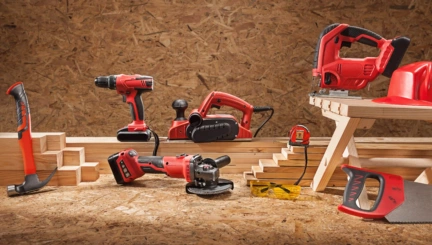- 25min
- 12497
- 0
Ever tackled a home improvement project and found yourself staring at a drawer full of mysterious pliers? You’re not alone! Pliers come in all shapes and sizes, each with its own special talent. This friendly guide will be your one-stop shop for understanding the wonderful world of pliers [types of pliers with pictures]. We’ll break down the different types, explain what makes them tick, and show you exactly what they’re good for. No more wrestling with the wrong tool! Whether you’re a seasoned DIYer or a curious beginner, this guide will equip you with the knowledge to choose the perfect pliers for any gripping, cutting, or bending task. So, grab your pliers, roll up your sleeves, and let’s get handy together!

Different Types of Pliers and Their Uses
Pliers are like the Swiss Army knife of gripping tools – always there to lend a hand (or two!). But with so many shapes and sizes, it’s easy to get confused about the different kinds of pliers. Don’t worry, this guide will be your cheat sheet to these trusty tools!
We’ll explore the most common types of pliers (and their pictures!) and what makes them special. From grabbing tiny wires to twisting stubborn bolts, you’ll be a plier pro in no time. So, let’s dive in and meet all types of pliers with names that will become your new favorite go-to helpers!

What Are Pliers Used For?
Pliers are the ultimate team players in your toolbox! They’re those handy tools you reach for when you need a good, strong grip on something. But their talents go way beyond just holding tight. Here’s a rundown of the many ways pliers can help you out:
- Gripping: This is their bread and butter! Pliers can clamp down on all sorts of objects, from tiny wires to hefty nuts and bolts. No more struggling with your fingers – pliers give you the extra grip and leverage you need.
- Twisting: Need to turn a stubborn screw or bend some wire into shape? Pliers come to the rescue! Their jaws can grab and twist with force, making light work of those tricky tasks.
- Cutting: Many types of pliers have built-in cutters, perfect for snipping wires or even small bolts. No need for separate tools – these multi-talented pliers can handle both gripping and cutting jobs.
- Bending: Got some metal you need to gently coax into a new shape? Pliers can help you bend wire, sheet metal, or other pliable materials with precision and control.
Order Wholesale Pliers Designed to Attract Customers
As you can see, pliers are like the ultimate all-rounder in your toolbox. They might not be fancy, but they’re incredibly versatile and can tackle a surprising number of tasks!

What is the Most Common Type of Pliers?
When it comes to popularity in the pliers world, the combination pliers reign supreme! They’re the most commonly used type of pliers and can handle a wide range of jobs.
These versatile pliers combine three key features in one handy tool:
- Gripping jaws: Perfect for grabbing nuts, bolts, wires, or any object that needs a secure hold.
- Wire cutters: Built-in cutters let you snip wires or small bolts with ease, saving you the need for separate tools.
- Serrated surface: The jaws often have a textured surface that helps grip objects tightly and prevents them from slipping.
Read more: Best Wire Cutters
So, if you’re just starting out and unsure which pliers to get first, combination pliers are a fantastic choice. They’re a reliable all-rounder that will come in handy for countless projects around the house!
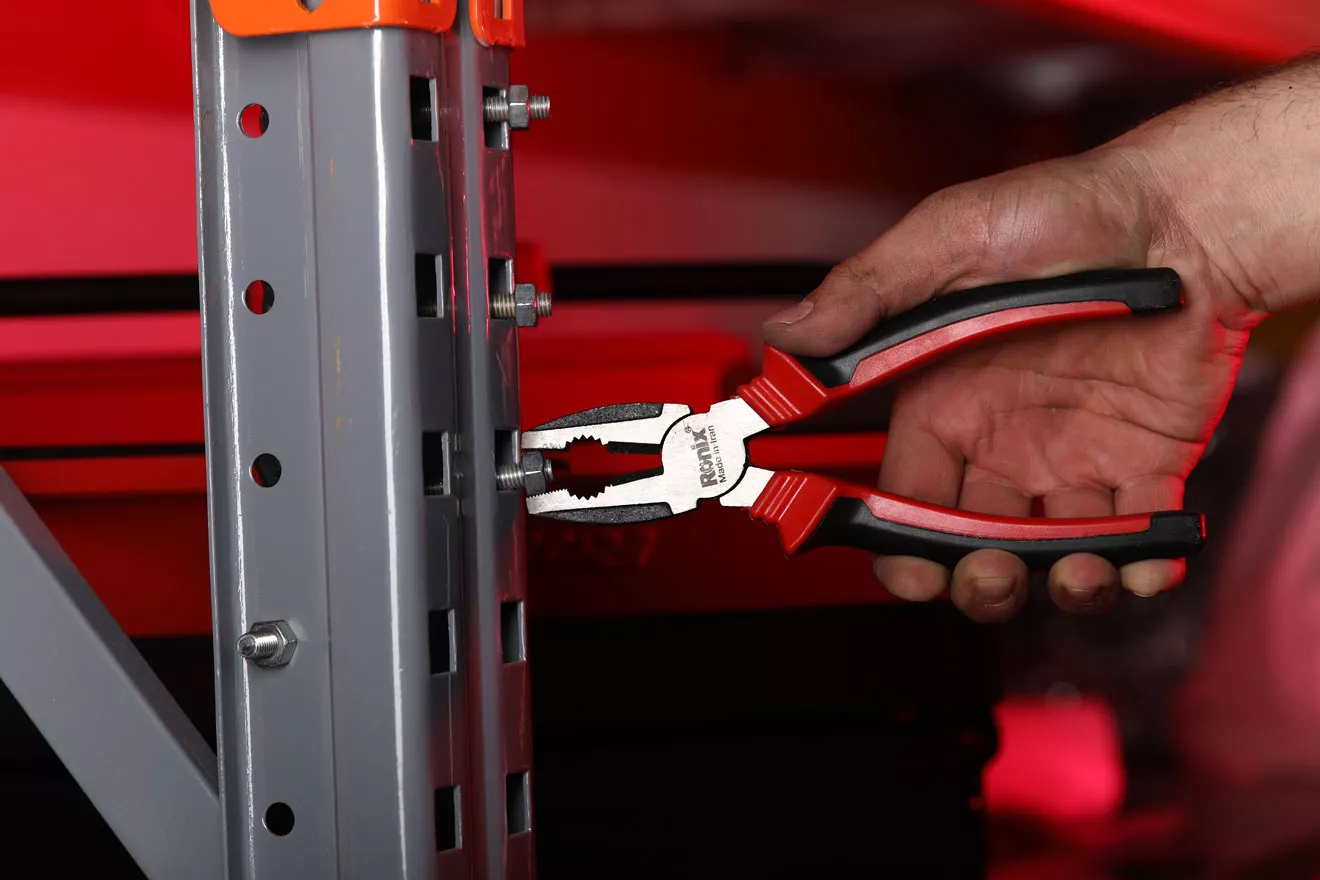
What Are Different Names for Pliers?
While “pliers” is the most common term, these versatile tools can sometimes wear different hats (or handles) and go by other names, depending on their specific design and purpose. Here’s a quick guide to some of their aliases:
- Snips: This term usually refers to pliers with a focus on cutting, often featuring smaller jaws and powerful cutters for tackling wire or thin metal.
- Pincers: This is a more general term for any tool used for gripping and manipulating objects, and can sometimes be used interchangeably with pliers.
- Cutters: Similar to snips, this term emphasizes the cutting function of certain pliers, like bolt cutters used for heavy-duty wire or metal.
- Forceps: This term is more commonly used in medical settings, but it can also refer to small, delicate pliers used for precision work like jewelry making.
- Clamps: While not technically pliers, some locking pliers can function similarly to clamps, providing a strong, secure hold on an object.
Read more: History of Pliers
So, next time you’re looking for a specific tool, don’t be surprised if you encounter these other terms. Just remember, they might all be referring to the trusty pliers hiding in disguise within your toolbox!

Types of Pliers for Electrical Work
When it comes to electrical tasks, safety is vital! That’s where insulated pliers come in – your essential teammates for any electrical project. These pliers are specially designed with non-conductive materials on the handles to prevent electrical shock.

There are two main types of insulated pliers commonly used for electrical work:
- Lineman’s Pliers: These heavy-duty pliers are a favorite among electricians. They feature:
- Strong jaws: Perfect for gripping wires, cutting cables, and even crimping connectors (attaching terminals to wires).
- Built-in cutters: For snipping wires with ease.
- Long, insulated handles: Providing extra leverage and keeping your hands a safe distance from live wires.

- Needle-Nose Pliers: While not exclusive to electrical work, insulated needle-nose pliers are another valuable tool. Their long, slender jaws excel at:
- Reaching into tight spaces: Like electrical boxes or behind appliances, to grab wires or manipulate small components.
- Gripping delicate wires: Without damaging them.
- Bending wires: For shaping and positioning them during electrical work.
Read more: Best Pliers
Remember, even with insulated pliers, always prioritize safety when working with electricity. Turn off the power whenever possible, and consult a qualified electrician for any complex tasks. These insulated pliers are there to assist you with safe handling, not replace proper safety measures!
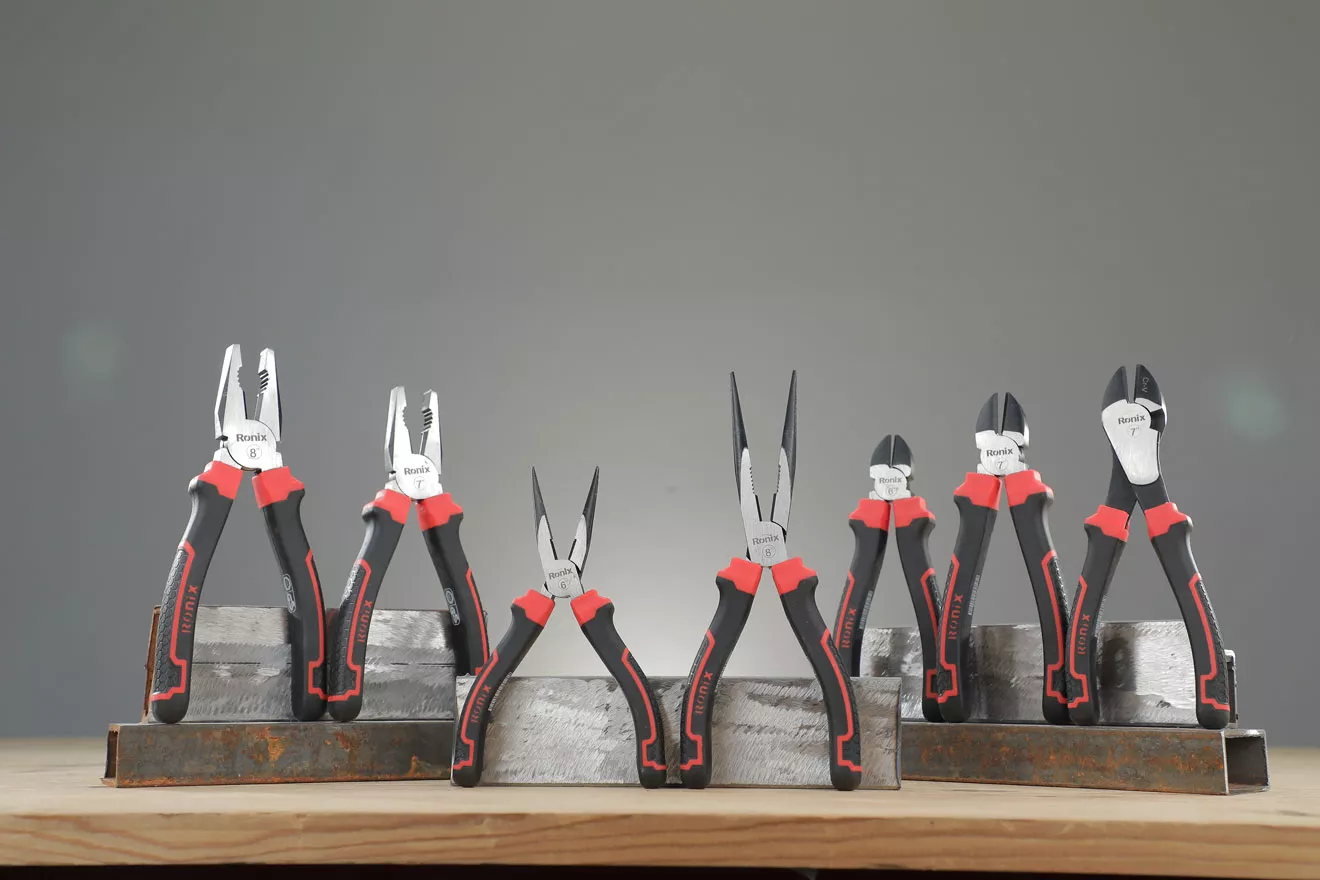
What Types of Pliers Are Used to Cut Heavy-Duty Wires?
Not all wires are created equal, and some require a more powerful approach when it comes to cutting. For those tough jobs, fear not! Your toolbox heroes, pliers, come to the rescue once again, but this time in the form of diagonal cutters (also known as diagonal pliers or side cutters).

These pliers are specifically designed to tackle heavy-duty wires with their impressive features:
- Sharp, Beveled Cutting Edges: Unlike regular scissors, diagonal cutters don’t have a flat, straight cutting edge. Instead, they boast a sharp, angled bevel that acts like a tiny guillotine. This concentrated cutting power allows them to effortlessly shear through thick wires.
- Strong Leverage: The handles of diagonal cutters are designed for leverage, providing you with the extra gripping force needed to cleanly cut through even the most stubborn wires.
- Compact Design: Despite their strength, diagonal cutters are relatively compact, making them easy to maneuver and use in tight spaces.
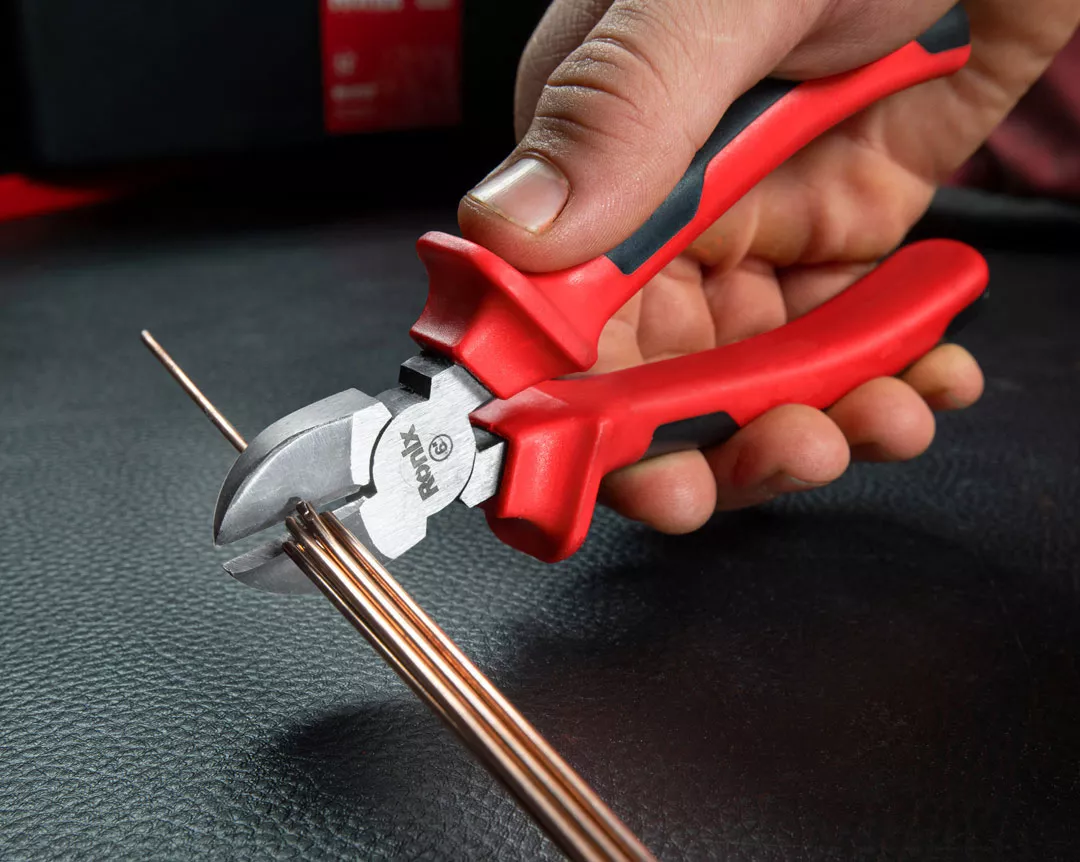
So, next time you face a thick cable or wire that needs to be cut, ditch the kitchen shears and grab your trusty diagonal cutters. They’ll make the job a breeze, leaving you with a clean, precise cut.
Carpenter Pincer 8 inch Ronix RH-1520
Long-Nose Pliers Uses: The Reach Around
Long nose pliers are the ultimate problem-solvers for those hard-to-reach situations. Imagine tiny wires hiding deep within an appliance, or a stubborn screw wedged in a tight corner. That’s where the uses of long nose pliers really shine, with their slender jaws that can navigate seemingly impossible spots. Here’s a glimpse into the many uses of long-nose pliers:

- Reaching into tight spaces: As their name suggests, long nose pliers excel at reaching into cramped areas where your fingers just can’t fit. This makes them invaluable for electrical work, jewelry making, or any project requiring precision maneuvering in tight spots.
- Gripping small objects: Those tiny nuts, bolts, or delicate wires that seem impossible to grab become easy targets for long-nose pliers. Their thin jaws can clamp down securely on even the most minuscule objects, giving you the control you need.
- Bending wire: Need to bend some wire into a specific shape? Long nose pliers offer the perfect combination of grip and control, allowing you to gently bend wire without kinking or breaking it.
- Cutting wire: Many long-nose pliers come equipped with built-in wire cutters, making them a multi-functional tool. You can use them to snip wires to size or remove unwanted pieces with precision.
Our suggestion: Long Nose Plier 8 Inch-Maxi Series

So, next time you encounter a fiddly task or a tiny object hiding in a nook, don’t underestimate the power of long-nose pliers. They’re the ultimate tool for reaching around obstacles and getting the job done with finesse.
Read more: Best Needle-Nose Pliers
Circlip Pliers Types: The Snap Ring Whisperers
Circlips, those tiny but crucial retaining rings, can be tricky to handle. That’s where circlip pliers come in, your secret weapon for installing and removing these essential components. But circlip pliers aren’t one-size-fits-all. They come in two main types, each designed to tackle a specific circlip situation:
- Internal Circlip Pliers: Imagine a circlip nestled snugly inside a groove. That’s where internal circlip pliers take center stage. Their jaws are designed to reach inside the bore (hole) and compress the circlip, allowing you to easily slip it out of its groove.
- External Circlip Pliers: For circlips that sit on the outside of a shaft, like a tiny guardian keeping things in place, external circlip pliers are your go-to tool. Their jaws spread open the circlip, creating space for you to slip it off the shaft and onto its rightful place.
By having both internal and external circlip pliers in your toolbox, you’ll be prepared to handle any snap ring challenge that comes your way!
Circlip Pliers Uses: Taming the Tiny Titans
Circlips, despite their small size, play a big role in holding components together in various machines and devices. But what if a circlip needs replacing? That’s where circlip pliers come in – the essential tool for installing and removing these tiny titans.

Here’s a closer look at how circlip pliers are used:
- Circlip Removal:
- Identify the type of circlip (internal or external) and choose the corresponding pliers.
- Insert the plier tips precisely into the designated holes on the circlip.
- Squeeze the handles, compressing the internal circlip or spreading the external circlip open.
- Carefully maneuver the circlip out of its groove and remove it completely.
- Circlip Installation:
- Select the appropriate pliers and the new circlip that matches the size and type required.
- Position the new circlip into the designated groove (internal or external) on the machine component.
- Use the circlip pliers to compress the internal circlip or spread the external circlip open.
- Carefully guide the circlip into its final position, ensuring it snaps securely into the groove.

Remember, using the correct type of circlip pliers and the proper technique is crucial to avoid damaging the circlip or the surrounding components. With these handy pliers and a little practice, you’ll be a circlip-handling pro in no time!
Types of Jewelry Pliers and Its Uses: Bling It On
So you’ve got the creative spark to craft amazing jewelry, but what about the tools to turn those ideas into reality? Dive into the world of different types of jewelry pliers, your secret weapons for building your bling empire! Each type of plier has a special superpower to help you achieve jewelry-making mastery.

Here’s a breakdown of some all-star pliers you’ll want in your toolbox:
- Round-Nose Pliers: Think of these as your wire-bending studio. Their smooth, rounded jaws are perfect for creating flawless loops and curves. These loops and curves become the building blocks for tons of cool jewelry designs, from jump rings and clasps to fancy swirls and decorations.
- Flat-Nose Pliers: These pliers are your BFFs for grabbing and shaping wire with precision. Their flat jaws act like a tiny vise, holding the wire nice and tight while you bend it exactly how you want. Perfect for creating clean lines and crafting little frames (called bezels) to hold your gemstones.

- Chain-Nose Pliers (a.k.a. Snipe Nose Pliers): These pliers are like the Swiss Army knife of the jewelry world. They combine the gripping power of flat-nose pliers with a pointy tip that can reach into tiny spaces. This makes them super handy for opening and closing jump rings (a jewelry must-have!) and for holding small parts while you add those special touches to your creations.
- Needle-Nose Pliers: While not exclusive to jewelry making, these pliers are another awesome tool to have on hand. Their long, slender jaws are like tiny fingers, perfect for reaching into tight spots and grabbing those teeny-tiny beads. They can also help you open up jump rings in tricky areas or straighten out any bent wire with a gentle touch.

As your skills flourish, you might even consider expanding your plier collection to include specialty pliers for even more intricate tasks. But with these essential pliers as your foundation, the creative possibilities are endless.
Read More: Best Pliers for 6 Different Applications and Their Brands
Types of Needle Nose Pliers: The Pointed Posse
did you know there’s more than one kind of needle nose plier? While they all share the general design of long, slender jaws, some variations offer additional features to tackle specific tasks. Here’s a peek at the different types of needle nose pliers you might encounter:

- Standard Needle Nose Pliers: These are the classic version, featuring smooth jaws and a pointed tip. They’re perfect for basic gripping, bending, and cutting tasks in confined areas. Many standard needle nose pliers also have built-in wire cutters near the base of the jaws, making them even more versatile.
- Angled Needle Nose Pliers: As the name suggests, these pliers have jaws that are bent at an angle, typically between 45 and 90 degrees. This angled design allows you to reach into even tighter spaces or grip objects at an odd angle that straight needle nose pliers might struggle with.

- Curved Needle Nose Pliers: These pliers have a slight curve to their jaws, making them ideal for tasks that require a bit more finesse. They’re particularly useful for grabbing or manipulating wires or small components that might be bent or oddly shaped.
- Electronic Needle Nose Pliers: Designed specifically for delicate electrical work, these pliers often have features like:
- Ultra-fine tips: For handling tiny wires and electronic components with precision.
- Soft grips: To prevent damage to sensitive components.
- Anti-static properties: To minimize the risk of electrostatic discharge (ESD) which can damage electronic components.
Don’t underestimate the power of having the right tool for the job! With a variety of needle nose pliers at your disposal, those fiddly tasks that used to leave you frustrated can be tackled with confidence.
Types of Long Nose Pliers
While there’s some overlap between needle nose pliers and long nose pliers, it’s worth mentioning that long nose pliers themselves can have some variations too! Here’s a look at Types of Long Nose Pliers:
- Standard Long Nose Pliers: These are the workhorses of the long nose family. They share many features with standard needle nose pliers, including long, slender jaws and a straight tip. However, long nose pliers may have slightly wider jaws or a less pointed tip compared to needle nose pliers, making them better suited for gripping larger objects or objects with a rounded shape.
- Long Nose Pliers with Side Cutters: This variation builds upon the standard long nose plier by incorporating built-in wire cutters near the base of the jaws. This makes them a multi-functional tool, allowing for gripping, bending, and cutting tasks without needing to switch between pliers.

- Chain Nose Pliers (a.k.a. Snipe Nose Pliers): These pliers often get grouped under both long nose pliers and jewelry pliers due to their versatility. They share some characteristics with both, featuring jaws that are slightly longer and more tapered than standard long nose pliers, but not quite as slender as needle nose pliers. This tapered design allows for both gripping and reaching into tight spaces. They’re a favorite among jewelry makers for opening and closing jump rings.
Remember, the specific functionalities might vary slightly depending on the brand or manufacturer. But overall, these different types of long-nose pliers offer a range of gripping, bending, and cutting capabilities in those hard-to-reach areas. So, next time you’re faced with a project requiring precision maneuvering in tight spots, consider the various long-nose pliers available to find the perfect tool for the job!
Types of Vise Grip Pliers: Clamp Down Tight
Vise grip pliers, also known as locking pliers, are the undisputed heavyweight champions of grip strength in the pliers toolbox. Forget about muscles – these pliers give you a vice-like hold on any object with a simple squeeze. They come in various forms, each offering unique ways to clamp down on objects securely. Here’s a breakdown of some common types of vise grip pliers:

- Original Locking Pliers: These are the classic vise grips, featuring a self-adjusting lower jaw and a locking mechanism. Simply squeeze the handle to adjust the grip on the object, then lock it in place with the lever. They’re perfect for tasks requiring a strong, sustained hold on objects of various shapes and sizes, like turning stubborn nuts and bolts, holding pipes for cutting or threading, or even acting as a makeshift clamp.
- Trigger Release Locking Pliers: Building on the original design, these pliers offer a one-handed operation with a trigger release mechanism. This allows you to lock and release the grip with just one hand, freeing up your other hand for maneuvering the object or using another tool.

Alt: Ronix Plier
Curved Jaw Locking Pliers: These pliers are similar to the original design but have curved jaws. This curved design makes them ideal for gripping around objects with a rounded shape, like pipes or tubes, providing a more secure hold compared to straight jaw pliers.
- Locking C-Clamps: These aren’t technically pliers, but they function similarly to locking pliers. They feature a C-shaped body with a screw mechanism that tightens the jaws, creating a strong, even clamp. Locking C-clamps are ideal for woodworking or metalworking tasks where you need to apply pressure in a straight line, like gluing wood pieces together or holding metal sheets in place for drilling or welding.
- Welding Locking Pliers: Designed for the high-heat environment of welding, these pliers often have heat-resistant handles and are built to withstand the demands of welding projects. They can be used for clamping metal pieces together for welding or holding hot objects securely.
Types of Lineman Pliers: The Electrician’s Multi-Tool
Lineman pliers, also sometimes called lineman’s pliers or combination pliers, are the workhorses of electrical work. They’re a must-have tool for electricians and anyone who needs a versatile plier for electrical tasks. These pliers combine several functionalities into one handy tool, making them a true friend for tackling various electrical projects. Here’s what makes lineman pliers so special:
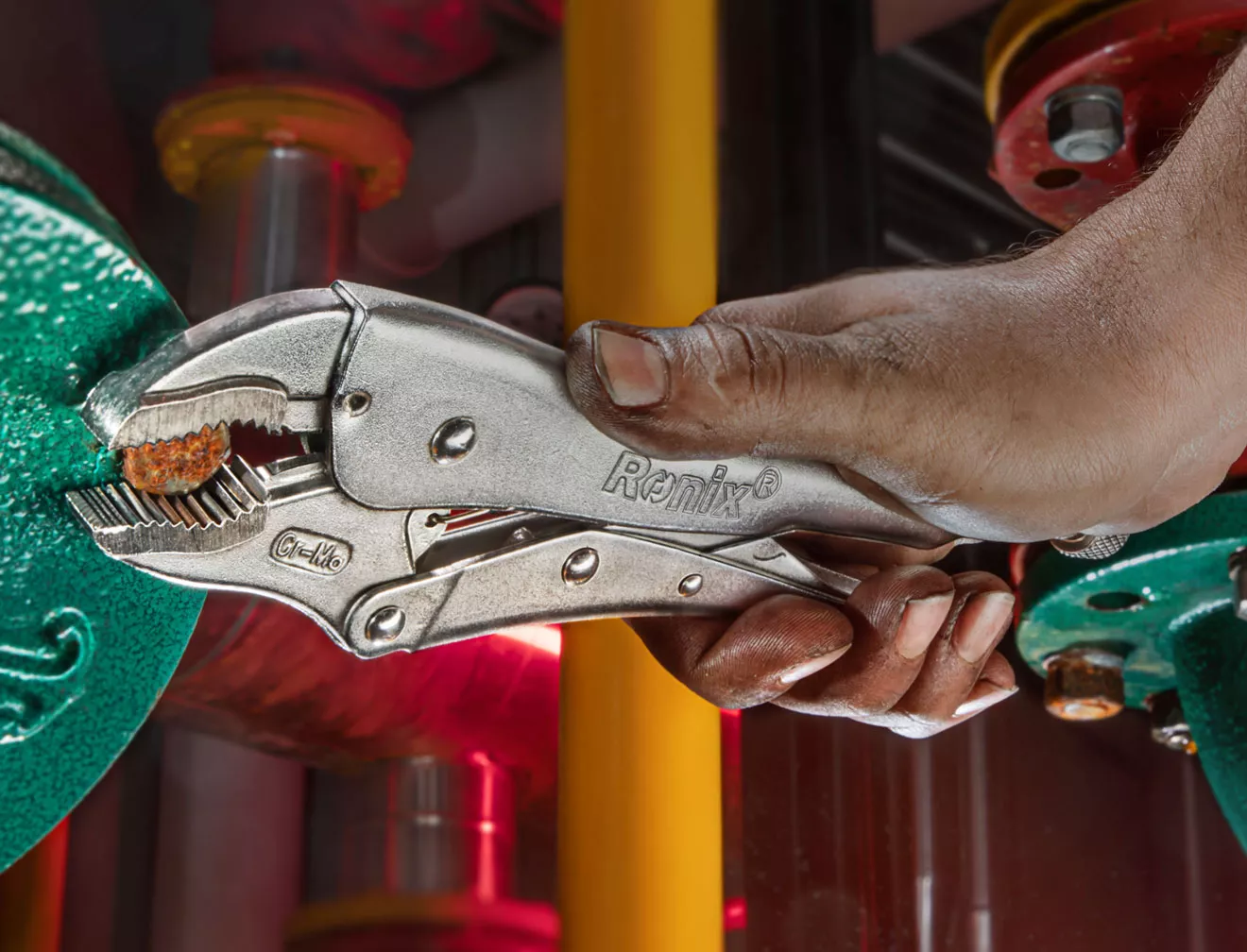
- Heavy-Duty Construction: Unlike your standard pliers, lineman pliers are built tough. They’re typically constructed from high-quality forged steel, making them durable enough to handle heavy-duty electrical tasks like cutting cables and crimping connectors.
- Multi-Functional Jaws:
- Gripping Surfaces: The flat, serrated jaws provide a secure grip on wires, cables, and other electrical components. This allows you to hold wires firmly for cutting, stripping, or connecting them.
- Cutting Edges: Most lineman pliers have built-in cutting edges near the base of the jaws. These are specifically designed to cut through electrical wires and cables cleanly and efficiently.
- Crimping Tool (Optional): Some lineman pliers come with a built-in crimper at the end of the handles. This crimper allows you to attach terminals (connectors) to wires securely with a simple squeeze.
- Long, Insulated Handles: Safety first! Lineman pliers feature long, insulated handles made from non-conductive materials like rubber or plastic. This insulation helps protect you from electrical shock while working with live wires. Remember, even with insulated pliers, always prioritize safety when working with electricity. Consult a qualified electrician for complex tasks and always turn off the power whenever possible.

With their strong build, multi-functionality, and insulated handles, lineman pliers are the ultimate electrical problem-solvers. They can handle a variety of tasks, from gripping and cutting wires to crimping connectors, all while keeping you safe from electrical hazards.
Types of Locking Pliers: Holding Tight
Locking pliers, also known as vise grips, are the ultimate grip masters in the toolbox. Forget about relying on muscle strength – these clever tools clamp down on objects with impressive force, giving you a secure hold whenever a regular grip just isn’t enough. But within the locking pliers family, there’s a surprising variety, each offering a unique way to secure objects. Here’s a breakdown of some of the most common locking pliers you might encounter:

- Original Locking Pliers: These are the classic design, the granddaddies of locking pliers. They feature a self-adjusting lower jaw and a simple locking mechanism. Just squeeze the handle to adjust the grip on your object, then lock it in place with the lever. These versatile pliers are perfect for tasks requiring a strong, sustained hold on objects of various shapes and sizes. Think turning stubborn nuts and bolts, holding pipes for cutting or threading, or even acting as a makeshift clamp.
- Trigger-Release Locking Pliers: Building on the original design, these pliers offer a more convenient one-handed operation with a trigger release mechanism. This allows you to lock and release the grip with just one hand, freeing up your other hand for maneuvering the object or using another tool. Perfect for situations where you need to adjust the grip quickly or work in tight spaces.
- Curved Jaw Locking Pliers: As the name suggests, these pliers have jaws that curve inwards. This curved design makes them ideal for gripping around objects with a rounded shape, like pipes or tubes. The curved jaws conform better to the object’s shape, providing a more secure hold compared to straight jaw pliers.
- Locking C-Clamps: While not technically pliers, locking C-clamps function similarly. They feature a C-shaped body with a screw mechanism that tightens the jaws, creating a strong, even clamp. Locking C-clamps are ideal for woodworking or metalworking tasks where you need to apply pressure in a straight line, like gluing wood pieces together or holding metal sheets in place for drilling or welding. Their C-shaped design allows for even pressure distribution across the entire clamping surface.
- Welding Locking Pliers: Built for the high-heat environment of welding, these pliers often have heat-resistant handles and are sturdier than their standard counterparts. They can be used for clamping metal pieces together for welding or holding hot objects securely without fear of the handles melting or warping.

- Specialty Locking Pliers: The world of locking pliers extends beyond these common types. There are specialty pliers designed for specific tasks, such as:
- Chain Grip Locking Pliers: Designed for gripping chains securely, often with built-in hooks or grooves in the jaws.
- Long Reach Locking Pliers: Feature extended handles for reaching into tight spaces or deep objects.
- Angled Jaw Locking Pliers: Jaws are angled at a specific degree for gripping objects at an odd angle.
By understanding the different types of locking pliers and their functionalities, you’ll be well-equipped to tackle various tasks that require a strong, secure hold. So, next time you encounter a stubborn object that needs gripping, reach for the right locking pliers and clamp down with confidence!
Types of Combination Pliers
Combination pliers, often referred to as lineman’s pliers or linesman pliers (though not exactly the same), are the jack-of-all-trades in the pliers world. They might not be the most specialized tool, but their versatility makes them a must-have for any toolbox. Here’s a deeper look at why combination pliers are so widely used and the different variations you might encounter:

- The Classic Combination: These pliers are the workhorses of the bunch. They typically feature three key components:
- Gripping Jaws: The flat, serrated jaws provide a secure hold on various objects, from nuts and bolts to wires and cables. The serrations prevent objects from slipping, ensuring a tight grip.
- Wire Cutters: Built-in cutting edges near the base of the jaws allow you to snip wires or small bolts with ease. This eliminates the need for a separate cutting tool, making combination pliers a multi-functional problem-solver.
- Moderate Jaw Size: The jaw size of combination pliers falls somewhere between needle nose pliers and lineman pliers, offering a balance between precision and gripping power. This makes them suitable for a wider range of tasks.
- Long Nose Combination Pliers: These pliers take the classic design and add some extra reach. They feature slightly longer jaws than standard combination pliers, making them ideal for reaching into tight spaces or grabbing objects that are just out of reach.
- Diagonal Cutting Combination Pliers: While some combination pliers have basic wire cutters, these pliers prioritize cutting with a more robust design. They often feature thicker jaws and heavy-duty diagonal cutters specifically designed to tackle thicker wires or even small bolts.
- Insulated Combination Pliers: Safety first! These pliers are specifically designed for electrical work. They have the same functionalities as classic combination pliers, but their handles are insulated with non-conductive materials like rubber or plastic. This insulation helps protect you from electrical shock while working with live wires. Remember, even with insulated pliers, prioritize safety when working with electricity. Consult a qualified electrician for complex tasks and always turn off the power whenever possible.
While these are some of the most common variations, the world of combination pliers might offer even more specialized designs depending on the manufacturer. But no matter the specific type, combination pliers offer a winning combination of gripping, cutting, and basic manipulation capabilities, making them a reliable tool for countless projects around the house or on the job.
Automotive Types of Pliers: Gear Up for the Grease
The world under the hood can be a land of mystery and metal. But fear not, intrepid mechanic! With the right tools in your arsenal, you can conquer any automotive challenge. And when it comes to pliers, there are specific warriors best suited for these greasy battles. Here’s a breakdown of some essential pliers for your automotive toolbox:

- Diagonal Cutting Pliers: These are your go-to wire cutters. Their sharp, angled blades make quick work of snipping zip ties, vacuum hoses, and even some electrical wires (with proper precautions). They’re compact and versatile, allowing you to maneuver in tight spaces around the engine bay.
- Long Nose Pliers: Consider these the nimble fingers of your toolbox. Their slender jaws excel at reaching into tight spots and grabbing onto small components like cotter pins, wires, or fasteners. They can also be used for bending wire or holding parts securely while you work on them.
- Water Pump Pliers (Tongue and Groove Pliers): These pliers are the adjustable grip champions. Their jaws can be widened or narrowed to grip objects of various sizes, making them perfect for turning rounded objects like nuts, bolts, or even seized pipes. The angled head allows for better leverage and access in tight spaces around the engine.
- Hose Clamp Pliers: Ever wrestled with a stubborn hose clamp? These pliers are your savior. They feature specially designed jaws that fit around hose clamps, allowing you to easily loosen or tighten them without damaging the clamp or the hose itself. A lifesaver when replacing radiator hoses or other fluid lines.
- Snap Ring Pliers: Those seemingly insignificant circlips hold crucial components in place. Snap ring pliers come in two main types: internal and external. Internal pliers compress internal circlips for removal, while external pliers spread external circlips for easier removal or installation. Having both types ensures you’re prepared to tackle any circlip challenge that may arise.
Read More: Best Snap Ring Pliers of 2025
- Locking Pliers (Vise Grips): Sometimes, a regular grip just isn’t enough. Locking pliers come to the rescue in situations where you need a powerful, sustained hold. They can be used for turning stubborn nuts and bolts, gripping stripped threads, or even acting as a makeshift clamp for holding parts in place.
Suggested tool:
Ronix RH-1512 Tower Pincer 9 inch
Ronix RH-1513 Tower Pincer 10 inch
Remember, this is just a basic toolkit. Depending on the specific tasks you tackle, you might find other specialty pliers come in handy. But with this core selection of pliers in your toolbox, you’ll be well-equipped to handle a wide range of automotive repairs and maintenance projects, all while keeping your knuckles happy and those greasy gremlins at bay!
FAQs
What are needle nose pliers used for?
Great for grabbing small objects in tight spaces, bending wires, and cutting thin wires (often with built-in cutters).
What type of pliers are used to cut wire?
Diagonal cutting pliers are your best bet for general wire-cutting tasks.
What are water pump pliers used for?
These adjustable grip pliers are masters at turning rounded objects like nuts, bolts, or pipes, especially in tight spaces.
What are large pliers called?
There isn’t a universally recognized term for “large pliers,” but depending on the style, they could be called water pump pliers (adjustable jaws), lineman’s pliers (heavy-duty combo pliers for electrical work), or locking pliers (vise grips for powerful clamping).

Ronix
13 April 2024




